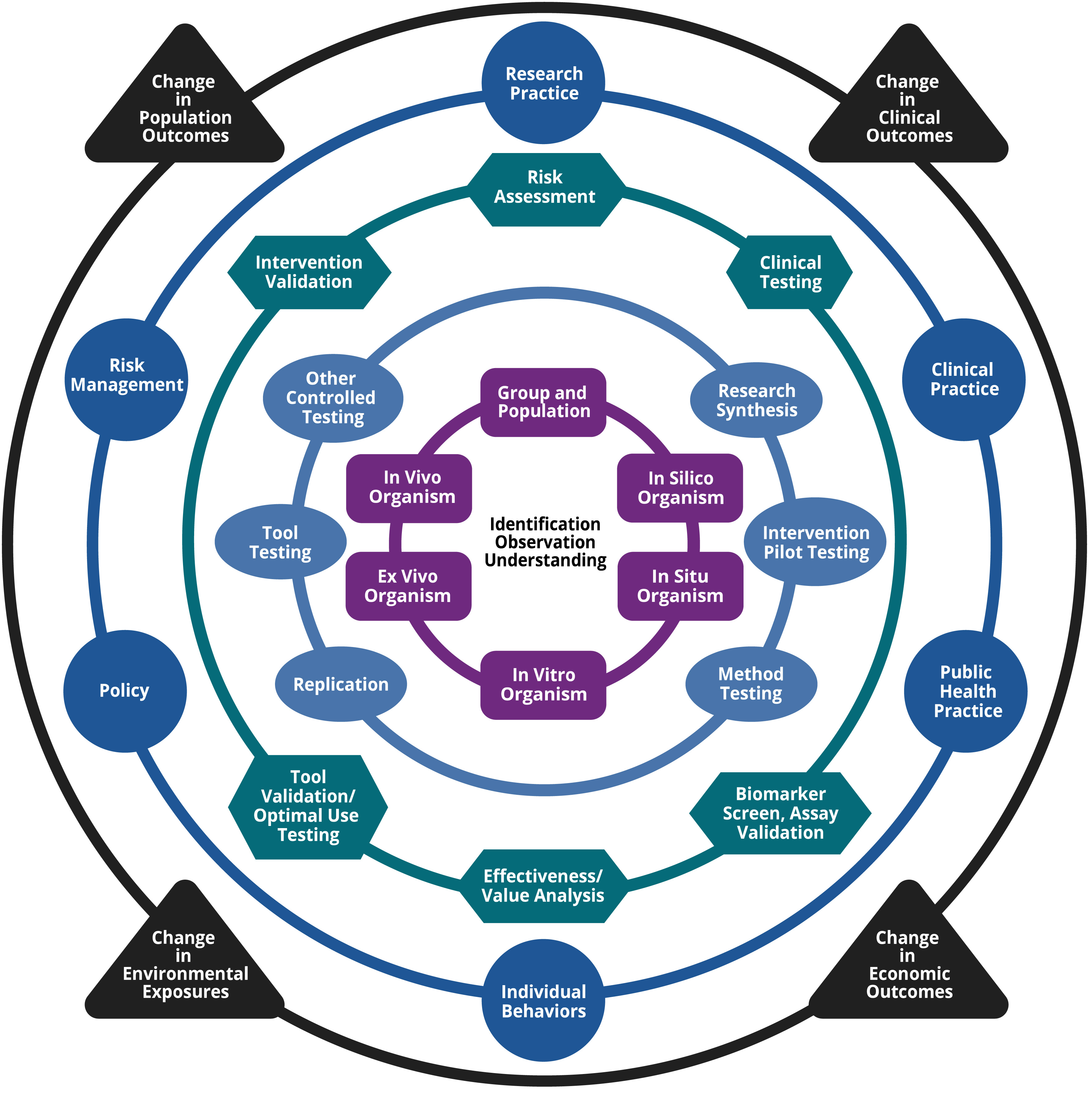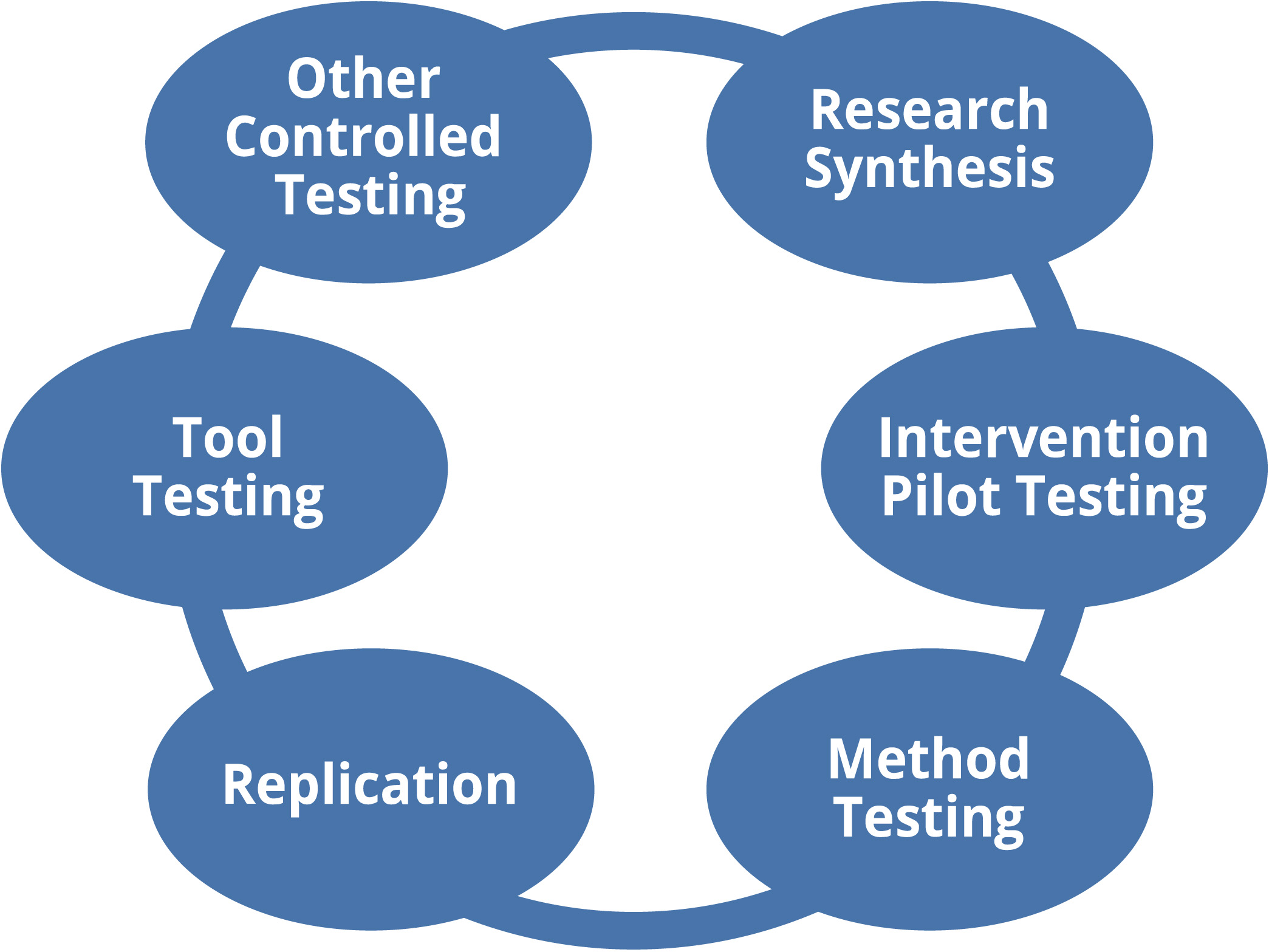The NIEHS concept of translational research enables us to track new ideas and knowledge as they move through the translational research process. This expanded framework integrates concepts from previous frameworks, and provides a space for environmental health science.
We developed the framework to codify the distinct categories of the translational research process as applied to environmental health. Below we describe the types of environmental health science that might occur in each category, while also providing a space for clinical research.
Overview
The NIEHS Translational Research Framework involves a series of rings that represent five primary categories of translational research. Each ring includes nodes along the rings that describe the types of activities that could be included. This level of detail allows researchers to tailor the model to tell a specific translational research story. The nodes that we have included reflect potential translational research activities related to environmental health science research. Others may wish to adapt these nodes to reflect research activities specific to other fields.
Translational Research Categories/Rings

Fundamental Questions
The 2018-2023 NIEHS Strategic Plan goal 1 describes fundamental research as research on the “biological processes of how our bodies function, and of the pathways and systems that are susceptible to the effects of environmental stressors. In working with examples, we found that the basic research questions NIEHS supports fall into three major categories:
- Identification: What is it?
- Observation: What is it doing?
- Understanding: How does it do that and what else is going on?
Our framework recognizes that fundamental research “addresses all levels of biological organization – molecular, biochemical pathway, cellular, tissue, organ, model organism, human, and population”. We place those categories at the center of the model and connect these questions with an associated experimental setting (in vivo, in vitro, in situ, in silico, or in a population at large), AND organism (human, animal, plant, bacteria, yeast, worm, fish, other model organisms, etc.). We suggest that these three elements are intrinsically linked, and moving from one category to another represents a clear translational bridge.
Movement around a Ring is Recognized as Translational Research
For example, if a translational research story starts with an observation from an epidemiological cohort study (observation/population/human) and then moves to a lab-based study designed to discover a mechanistic understanding of the effect of an environmental exposure using mouse tissue (understanding/ex vivo/mouse), then using our framework, the research would be recognized for crossing a translational bridge.
Application and Synthesis
Within the application and synthesis category, researchers conduct experiments in a structured and predictable setting to gain a deeper understanding of a process or effect. Such activities could include pilot tests of interventions, methods/approaches, new tools (e.g. exposure sensors) or other highly controlled settings. Also on this ring is the formal synthesis or integration of evidence from previous research to inform future research, risk assessment, and other decision making.
Implementation and Adjustment
The implementation and adjustment category is about implementing hypotheses in real-world settings and adjusting the product (intervention, tool, method, treatment, etc.) to account for differences in different settings and populations. Examples include biomarker, screen, or assay validation, clinical testing, tool validation and use, and effectiveness testing. Much of the current work in dissemination and implementation science would fit within this ring.
Practice
The practice category focuses on moving established ideas into common practice. This includes using evidence to inform new guidelines for: preventing, diagnosing, or treating exposures, illness, and disease; formalizing new public health interventions; institutionalizing local, regional, state, national, or international policy practices; informing standard risk management protocols; or motivating behavior change at individual, family, group, or population levels.
Impact
The impact category is where we assess the broader environmental, clinical, or public health impact of a practice, guideline, or policy. For example, if a state implemented a policy to reduce air pollution researchers might want to continue their research to assess the impact of the policy on air quality and related human health outcomes such as lung function or asthma rates.








